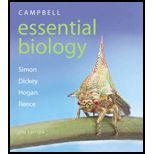
Interpreting Data Airborne pollen of wind-pollinated plants such as pines, oaks, weeds, and grasses causes seasonal allergy symptoms in many people. As global warming lengthens the growing season for plants, scientists predict longer periods of misery for allergy sufferers. However, global warming does not affect all regions equally (see Figure 18.44). The table below shows the length of the average season in nine locations for ragweed pollen, an allergen that affects millions of people. Calculate the change in length of the pollen season from 1995 to 2009 for each location and graph this information against latitude. Is there a latitudinal trend in the length of ragweed season? You may want to record the data on a map to help you visualize the geographic locations at which samples were taken.

Want to see the full answer?
Check out a sample textbook solution
Chapter 16 Solutions
Campbell Essential Biology Plus Mastering Biology with eText -- Access Card Package (6th Edition) (Simon et al., The Campbell Essential Biology Series)
- A plant biologist observed a peculiar pattern when a tropical shrub was attacked by caterpillars. After a caterpillar ate a leaf, it would skip over nearby leaves and attack a leaf some distance away. Simply removing a leaf did not deter caterpillars from eating nearby leaves. The biologist suspected that an insect-damaged leaf sent out a chemical that signaled nearby leaves. How could the researcher test this hypothesis?arrow_forwardIn your own words - grasses are flowering plants but many do not have colorful flowers. What mechanism do they use to spread their pollenarrow_forwardWRITE ABOUT A THEME: INTERACTIONS In a short essay(100–150 words), summarize phytochrome’s role in alteringshoot growth for the enhancement of light capturearrow_forward
- I am studying a plant. The sporophyte is the physically largest phase of this plant’s life cycle. This plant is a _____. Group of answer choices a fern It could be a fern, a pine tree or a rose bush. a rose bush a moss a pine treearrow_forwardWhat will likely happen to your plant if it will be placed in a dark area with no light? A.The plant will not be able to absorb sunlight B.No chlorophyll will be formed and the leaves will become whitish or pale yellow C.Plants will evolve to adapt in an environment with no light D.BothA and B E. BothA and Carrow_forwardSome plants in wetter climates release certain chemicals in response to leaf consumption by insects. These chemicals may either repel the leaf-eaters and/or attract other insects that will consume the leaf-eaters. A researcher was interested in whether desert plants emitted the same types of compounds. Desert plants have different kinds of leaves compared to plants from less arid areas. The researcher harvested Coville’s lip fern (Cheilanthes covillei) from deserts in Utah to bring into a greenhouse. The plants were 12 – 15 cm (5 – 6 in) tall. Each plant was placed in a separate pot, and there were 40 pots in all. Each pot was assigned to one of four “leaf eater” treatments: a control (i.e., no insects); 5 hornworms; 5 leaf bugs; or 5 flea beetles. Then the researcher measured the emission rate of a particular repelling compound from each plant once every hour for a total of 8 hours (8:00 am – 4:00 pm). Based on this scenario, please answer the following questions: a) What is the…arrow_forward
- A biologist finds that a plant is being attacked by beetle larva, which eats flowers. Later that same day, she observes that the air around the plant has an unusual "chemical" odour. Next day, she sees that there are many wasps stinging the caterpillars on the flowers. Give the most likely explanation for this observation and explain the underlyingconcept clearly.arrow_forwardIf you live in an area where it snows, picture road salt being put on this road in the winter; picture the thawing of snow and the splashing of water as trucks and cars move along. Where does this salt go? Is any of it present around you, and do you think it has any effect on the types of plants that grow here?arrow_forwardPREDICT If you transplanted the short-day plant discussed in Question 12 to the Equator, would it flower? Explain your answer.arrow_forward
- Pollination is an example of_____________ a possible source of new drugs chemical diversity an ecosystem service crop pest controlarrow_forwardFigure 21.6 The Svalbard seed vault is located on Spitsbergen island in Norway, which has an arctic climate. Why might an arctic climate be good for seed Storage?arrow_forwardA plant that opens its stomata only at night is a container with a lit candle, the mouse would die. But if he also added a plant to the container, the mouse could live. Priestley concluded that plants “purify” air, allowing animals to breathe. What is the biological basis for this observation? a. C2 plant. c. C4 plant. b. C3 plant. d. CAM plantarrow_forward
 Biology (MindTap Course List)BiologyISBN:9781337392938Author:Eldra Solomon, Charles Martin, Diana W. Martin, Linda R. BergPublisher:Cengage Learning
Biology (MindTap Course List)BiologyISBN:9781337392938Author:Eldra Solomon, Charles Martin, Diana W. Martin, Linda R. BergPublisher:Cengage Learning Concepts of BiologyBiologyISBN:9781938168116Author:Samantha Fowler, Rebecca Roush, James WisePublisher:OpenStax College
Concepts of BiologyBiologyISBN:9781938168116Author:Samantha Fowler, Rebecca Roush, James WisePublisher:OpenStax College Biology 2eBiologyISBN:9781947172517Author:Matthew Douglas, Jung Choi, Mary Ann ClarkPublisher:OpenStax
Biology 2eBiologyISBN:9781947172517Author:Matthew Douglas, Jung Choi, Mary Ann ClarkPublisher:OpenStax
 Biology Today and Tomorrow without Physiology (Mi...BiologyISBN:9781305117396Author:Cecie Starr, Christine Evers, Lisa StarrPublisher:Cengage Learning
Biology Today and Tomorrow without Physiology (Mi...BiologyISBN:9781305117396Author:Cecie Starr, Christine Evers, Lisa StarrPublisher:Cengage Learning




